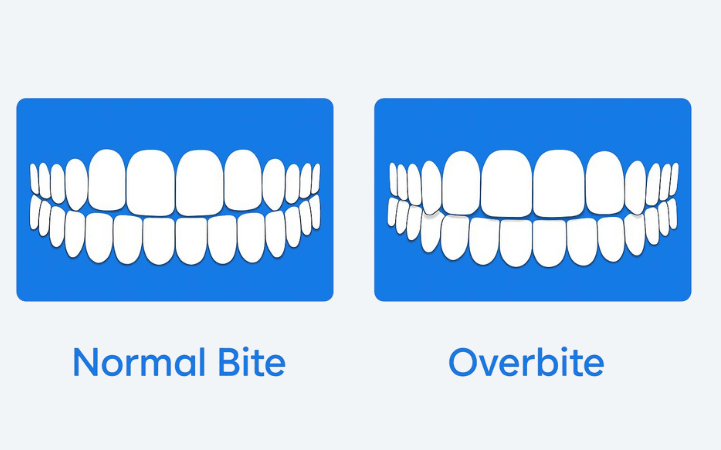Overbite vs Normal Bite: Differences, Symptoms & Treatment
Ever found yourself asking, “Is my bite normal?” You’re not alone. At first, an overbite might seem like just a cosmetic concern, but it’s deeper than that. The fact that you are here, sums up that you might be wondering about the real differences when the debate is about an “overbite vs normal bite”. Well, here’s the thing, the way your teeth come together isn’t just about aesthetics. Moreover, anyone with this condition faces problems with their biting mechanics and speech articulation coupled with facial structural changes. Undeniably, overbite cannot easily detect an overbite until it emerges. Furthermore, most people are unaware of their bite condition. So, let’s move forward and take a deeper look into this issue. What Is a Normal Bite? Before we get into the “overbite vs normal bite”, or some would say “normal teeth vs overbite debate”, let’s first get to know about the normal bite. Typically, a normal bite condition involves upper front teeth which overlap slightly beyond the lower teeth. What Do Normal Teeth Look Like? Moving forward, if you have normal teeth, your molars are likely to fit snugly together. Also, your jaw should move without any popping or discomfort. In short, everything works together smoothly. Why Is Proper Bite Alignment Important? Undeniably, proper alignment helps with chewing and reduces wear on teeth. Also, it prevents unnecessary jaw strain. However, if your biting mechanism is not perfectly aligned, it can cause severe headaches. Additionally, speech issues may also arise over time. What Is an Overbite? Now, to understand the context of overbite vs normal bite differences, it is significant that we first get to know about what overbite really is. Overbite Definition Medically speaking, an overbite exists when the upper front teeth completely or partially overlap the lower teeth while viewed from the front. However, different overbite cases exist from mild to moderate cases. Also, it may affect appearance, eating, or speaking. Types of Overbite (Dental vs Skeletal) Typically, a dental overbite is related to tooth placement. However, a skeletal overbite is related to jaw structure. Therefore, the early treatment approach depends on which type you have. Signs You May Have an Overbite Usually, signs can include jaw pain or difficulty chewing. Also, you might feel your teeth don’t close properly. On the other hand, worn enamel is another red flag. Moving forward, now that we have separately overviewed key differences between normal bite vs overbite, it’s time to dig deeper into the differences between overbite vs normal bite. Overbite vs Normal Bite – What’s the Difference? Here, we will take a more comprehensive peek into overbite vs normal bite differences. Visual Comparison Below, we have provided a picture to help you understand the differences when it comes to overbite vs normal bite: Functional Differences Health Implications Moving forward, when it comes to overbite teeth vs normal teeth, health implications can vary too. Overbite can lead to gum damage. In contrast, normal teeth are less likely to wear down early. Emotional and Social Impact Usually, the appearance of an overbite makes individuals typically experience distress about their appearance when they interact with others. Moreover, such inner doubts and esteem problems drive them toward refusing to show their teeth by smiling naturally. Now that we have viewed the key overbite vs normal bite differences, let’s have a look at the types of overbites and misalignments. Types of Overbites and Misalignments Moving forward, there are four main types of overbites: Vertical Overbite: The top front set of teeth extends far beyond the lower set vertically downward. Horizontal Overbite: The upper front teeth protrude beyond the lower teeth in an extensive forward position. Skeletal Overbite: Jawbone imbalance leads to this condition independently from tooth misalignment or position. Dental Overbite: Teeth that have either poor positioning or improper eruption patterns are responsible for this condition. Also, each needs different treatment. Furthermore, not all overbites are easy to spot. However, proper diagnosis can help. Overbite vs Overjet – Don’t Confuse the Two Besides the classic overbite vs normal bite debate, there are other confusing issues like the differences between overbite and overjet. Furthermore, in simpler words, an overbite is about vertical overlap. In contrast, overjet is about horizontal protrusion. Also, both can affect speech and appearance. What Causes an Overbite? Below, you can see a few factors that can cause an overbite: Genetic Factors Usually, genes choose your jaw structure along with determining your chance to develop an overbite. Moreover, the combination of inherited jaw dimensions and inherited tooth shapes damages the odds of obtaining an overbite. Childhood Habits On the other hand, long-term habits like thumb sucking during childhood age may also affect bite shape and jaw mechanism. Also, excessive use of pacifiers can further impact jaw development negatively. Jaw Growth Discrepancies Lastly, a mismatch develops when a patient experiences uneven jaw growth. Fortunately, identifying these issues early allows the use of clear aligners to correct dental problems promptly. Symptoms of a Misaligned Bite Now, let’s take a look at the common symptoms of a typical misaligned bite: Jaw Pain and TMJ In overbite cases, jaw pain is common. Moreover, Turbo Mandibular Joint Disorder (TMJ) symptoms can appear if the joint is stressed. Headaches and Earaches Furthermore, poor alignment also causes pressure in the head. Moreover, this condition often causes earaches and migraines together with frequent headaches. Speech Issues On the other hand, unclear speech may also stem from overbite problems. Moreover, it can make pronunciation tricky as well. Facial Asymmetry Lastly, severe overbites may lead to facial structure imbalance. Ultimately, this can affect how your profile looks. How to Fix an Overbite – Top 4 Options Undeniably, discussing the core differences between overbite vs normal bite might have helped you grasp the necessary information about the issue at hand. Below you can explore a few effective solutions to address this issue. Clear Aligners First, users can choose clear aligners as their overbite treatment method since they provide virtually undetectable teeth straightening solutions. Moreover, during
Overbite vs Normal Bite: Differences, Symptoms & Treatment Read More »










